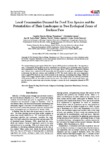Use este identificador para citar ou linkar para este item:
http://www.alice.cnptia.embrapa.br/alice/handle/doc/1018379Registro completo de metadados
| Campo DC | Valor | Idioma |
|---|---|---|
| dc.contributor.author | THIOMBIANO, D. N. E. | pt_BR |
| dc.contributor.author | LAMIEN, N. | pt_BR |
| dc.contributor.author | EULER, A. M. C. | pt_BR |
| dc.contributor.author | VINCENTI, B. | pt_BR |
| dc.contributor.author | AGUNDEZ, D. | pt_BR |
| dc.contributor.author | BOUSSIM, I. J. | pt_BR |
| dc.date.accessioned | 2015-06-23T11:11:11Z | pt_BR |
| dc.date.available | 2015-06-23T11:11:11Z | pt_BR |
| dc.date.created | 2015-06-23 | pt_BR |
| dc.date.issued | 2013 | pt_BR |
| dc.identifier.citation | Open Journal of Forestry, v. 3, n. 3, p. 79-87, 2013. | pt_BR |
| dc.identifier.uri | http://www.alice.cnptia.embrapa.br/alice/handle/doc/1018379 | pt_BR |
| dc.description | We examined demand and supply of Food Tree Species (FTS) products in Burkina Faso. The hypotheses were: 1) demand for FTS products by local communities exceeds what can be sustainably extracted, and 2) local communities of the Sudanian zone have access to more diverse FTS products compared to Sahelian zone. Surveys were conducted in 300 households and 360 quadrats in landscapes surrounding 6 villages to determine the diversity, richness and availability of FTS.The results indicate that local communities tend to exploit FTS which are rare to find or absent in the landscape surrounding their village. While the range of FTS largely exploited tends to coincide across the two ecological zones, the diversity and density of the preferred FTS are discordant between the two zones. The results of the present study further support the need for conservation and restoration strategies to sustain the local communities demand for FTS products. | pt_BR |
| dc.language.iso | eng | eng |
| dc.rights | openAccess | eng |
| dc.subject | Conhecimento indígena | pt_BR |
| dc.subject | Etnobotânica quantitativa | pt_BR |
| dc.subject | Quantitative Ethnobotany | pt_BR |
| dc.subject | Diversidade | pt_BR |
| dc.subject | Diversity | pt_BR |
| dc.title | Local communities demand for food tree species and the potentialities of their landscapes in two ecological zones of Burkina Faso. | pt_BR |
| dc.type | Artigo de periódico | pt_BR |
| dc.date.updated | 2015-07-02T11:11:11Z | pt_BR |
| dc.subject.thesagro | Consumo alimentar | pt_BR |
| dc.subject.thesagro | Segurança alimentar | pt_BR |
| dc.subject.nalthesaurus | food consumption | pt_BR |
| dc.subject.nalthesaurus | food security | pt_BR |
| dc.subject.nalthesaurus | indigenous knowledge | pt_BR |
| riaa.ainfo.id | 1018379 | pt_BR |
| riaa.ainfo.lastupdate | 2015-07-02 | pt_BR |
| dc.contributor.institution | DANIABLA NATACHA EDWIGE THIOMBIANO, Laboratoire de Biologie et d'Ecologie Végétales, Université de Ouagadougou, Ouagadougou, Burkina Faso; NIÉYIDOUBA LAMIEN, Département de Production Forestière, Institut de l'Environnement et de Recherches Agricoles, Koudougou, Burkina Faso; ANA MARGARIDA CASTRO EULER, CPAF-AP; BARBARA VINCETI, Bioversity International, CGIAR, Headquaters: Via Dei TreDenari, Rome, Italy; DOLORES AGUNDEZ, INIA-CIFOR, Dpto Sistemas y Recursos Forestales, Carretera de la Coruña, Madrid, Spain; ISSAKA JOSEPH BOUSSIM, Laboratoire de Biologie et d'Ecologie Végétales, Université de Ouagadougou, Ouagadougou, Burkina Faso. | pt_BR |
| Aparece nas coleções: | Artigo em periódico indexado (CPAF-AP)  | |
Arquivos associados a este item:
| Arquivo | Descrição | Tamanho | Formato | |
|---|---|---|---|---|
| CPAFAP2013LocalCommunitiesDemand.pdf | 994,32 kB | Adobe PDF |  Visualizar/Abrir |









